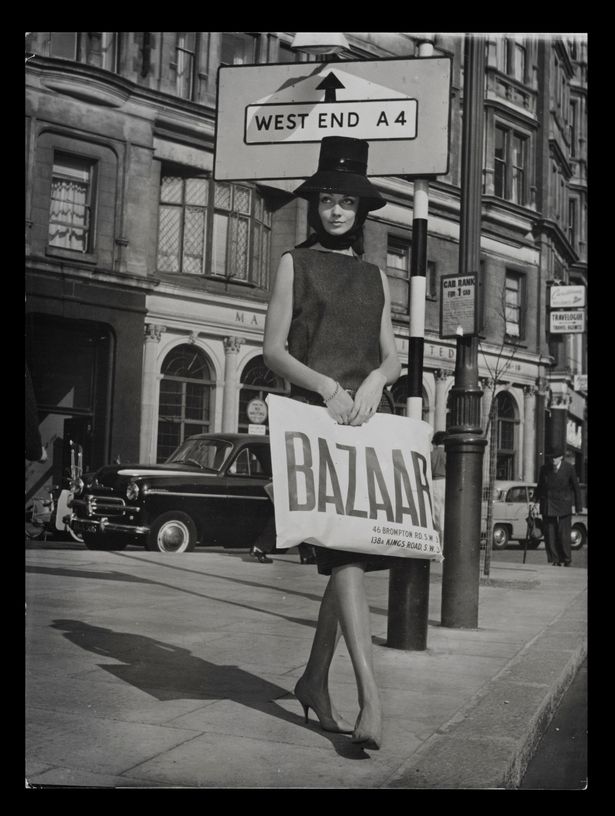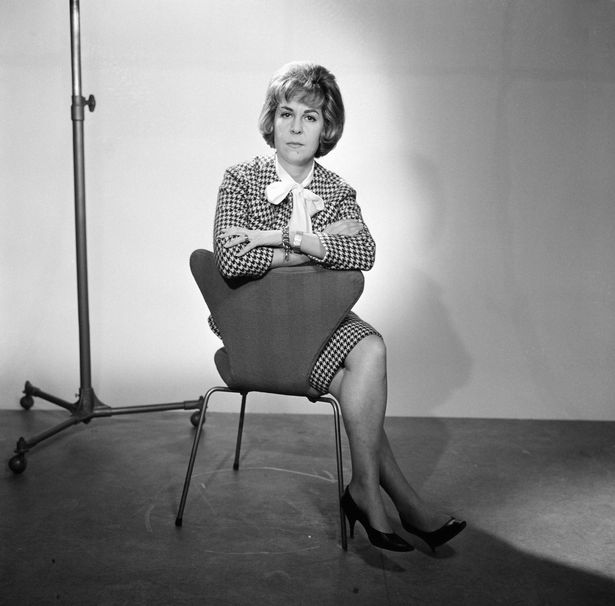There's no disputing Mary Quant revolutionised fashion. By harnessing youth spirit, street style and mass production she democratised it by making it available to all.
To put this into context in post war Britain the term fashion didn't really exist. Clothes were something enjoyed by a wealthy elite that had access to the world of couture that was dominated by Paris.
But Mary Quant challenged this system by creating a new forward looking identity for post-war Britain. She did this by defining the young, playful look of the 1960s and capitalising on the energy of sixties London.
A model holding a Bazaar bag outside Mary's boutique in 1959 (Image: Victoria and Albert Museum London)
From her experimental Kings Road boutique Bazaar she created affordable mass market clothing that embodied the spirit of the day. She personified the energy and fun of swinging London and became a powerful role model for the working women.
The Mirror's Assistant Editor Felicity Green photographed in 1962 (Image: Mirrorpix)
But while glossy magazines and tabloids dismissed her risque mini skirts as 'mad' and 'wayout' The Mirrors assistant editor Felicity Green helped to popularise her designs. By writing about Mary Quant's clothing she encouraged women to rebel against the traditional dress worn by their mothers and grand mothers.
Models in 1964 mini skirts parading the streets of London holding placards in support of the polarising trend (Image: PA)
When women saw Quant's skirts and dresses featured in the newspaper they instantly wanted to wear her designs. The Mirror also ran Mary’s dress patterns allowing everyone to recreate her look at home.
Mary Quant pictured reading the Daily Mirror newspaper in a rocking chair at home in London in 1967 (Image: Popperfoto/Getty Images)
Together they created main stream fashion and the high street as we know it. For the first time normal women could afford to access fashion.
Mary Quant framed by models wearing her mini skirts (Image: The LIFE Images Collection/Getty)
Mary's director or PR and Marketing Heather Tilbury explains: "Felicity Green's role was immeasurable because at a time when women's interests didn't have the same sort of coverage as now she fought for all the British designers and what they were doing and really underlined the vital role that they were playing, particularly for the young at that time.
"At the end of the fifties and in the sixties when they didn't want to dress like their mothers any longer. They wanted to have completely different clothes.
"And Felicity supported what they were doing because it was reflection of the excitement and vibrancy and fun that was going on at that time.
"And Felicity fought The Mirror to get her pages and they were wonderful. They were wonderful because they were accurate and she got it right. "
She saw the importance of what was going on and the far reaching effects into the States and into the rest of Europe. This put London on the map.
She made sure everybody knew what was going on. Mary licensed patterns and when she first started at Bazaar she bought paper Butterick patterns and cut off bits and added bits and that was how she started designing.
She realised she had to learn pattern cutting and later on in her career it was Butterick patterns that she subsequently designed for.
This meant that any body that had a length of fabric could cut out their own Mary Quant designs. Above all Mary believed with her passion for fashion that it was democratic and it shouldn't just be clothes only the wealthy could afford."
Mary Quant photographed with models wearing her iconic designs at Quant Afoot footwear collection launch in 1967 (Image: PA Archive/PA Images)
The V&A's retrospective is a nostalgic journey into the heart of a swinging sixties London. A time when a rebel youth spirit challenged conventions making way for a new age of feminism.
It brings to life how Mary inspired a generation of women to rebel against the traditional clothing worn by their mothers. The inventor of the mini skirt and mod fashion made clothing that reflected the new creative scene in London.
Mary's distinctive Vidal Sassoon wedge bob hairstyle (Image: Getty Images)
Her distinctive Vidal Sassoon wedge bob hairstyle, her iconic floral motif, her quirky mini dresses and platform shoes embodied a movement.
Mary used her designs to shatter those social norms – to show you don’t have to dress in a certain way to be seen as someone to take note of, you can experiment and have fun, but still be very chic and elegant.













